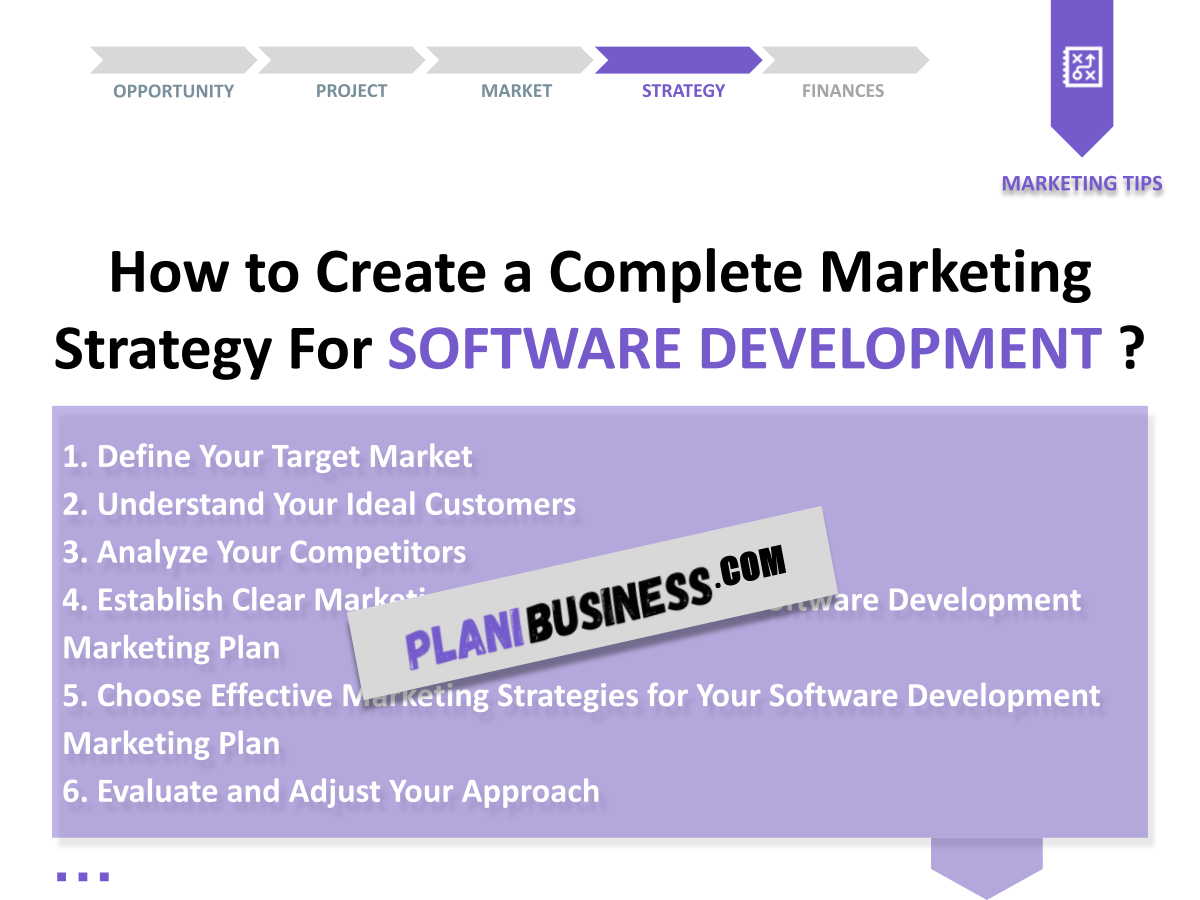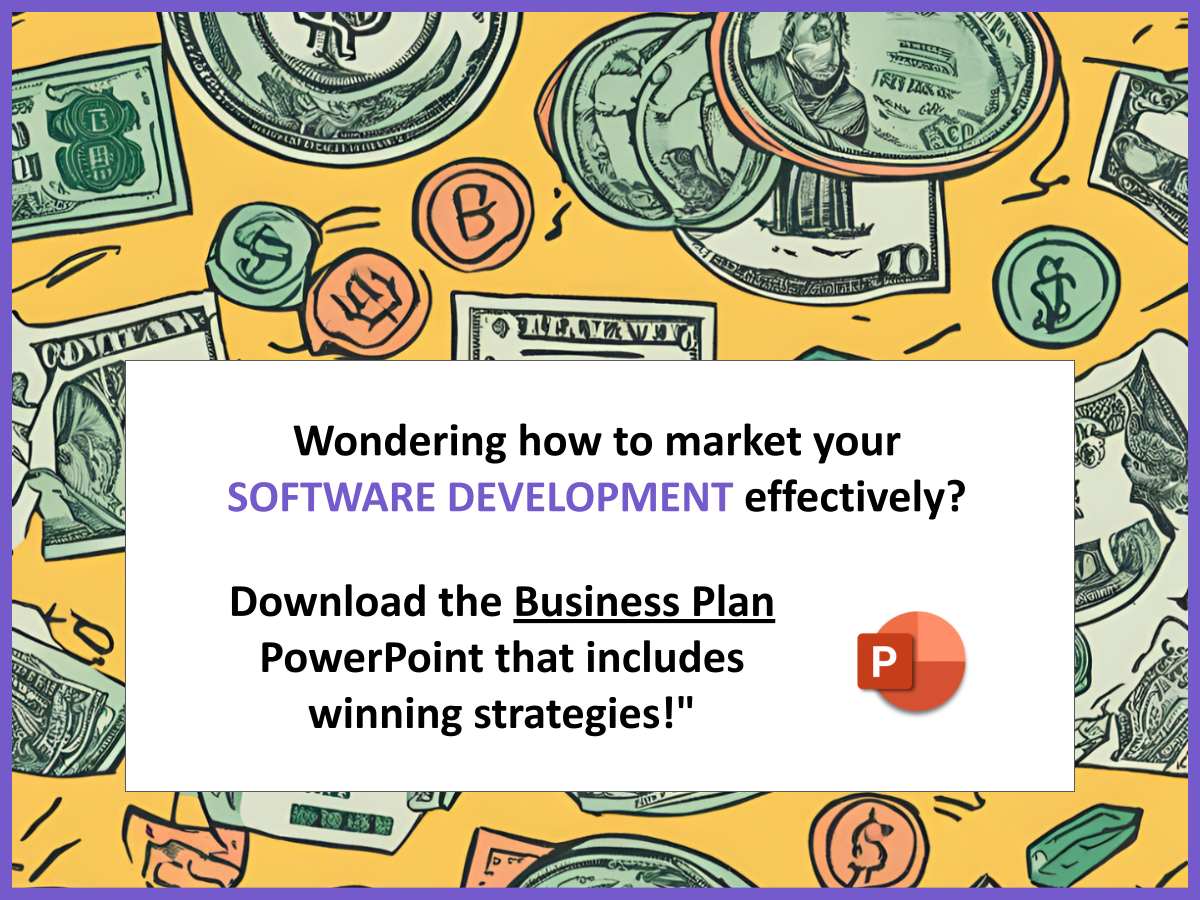Are you ready to elevate your software business? You’re not alone! Many entrepreneurs struggle with crafting a winning Software Development Marketing Plan. In fact, studies show that over 60% of startups fail to market their products effectively. This statistic is a wake-up call for anyone in the software development field!
A Software Development Marketing Plan is a strategic outline that helps businesses identify their target audience, set clear objectives, and choose effective marketing strategies. It’s essential for standing out in a crowded marketplace and ensuring your product reaches the right customers.
1. Define Your Target Market
| Aspect | Description |
|---|---|
| Demographics | Age, gender, location, and income level of potential customers. |
| Psychographics | Interests, values, and lifestyle choices that influence purchasing decisions. |
Understanding your target market is crucial. It helps tailor your marketing messages to resonate with potential customers. Use surveys and market research to gather data and create customer personas. Here’s a quick list to guide you:
- Conduct surveys to gather demographic information.
- Analyze social media engagement to understand interests.
- Utilize analytics tools to track website visitor behavior.
By gathering this information, you’ll be able to craft messages that truly connect with your audience. Remember, knowing who you’re talking to is half the battle won!
2. Understand Your Ideal Customers
| Factor | Details |
|---|---|
| Needs | Identify what problems your software solves for customers. |
| Behavior | Analyze how customers interact with similar products. |
By understanding your ideal customers, you can create targeted campaigns that speak directly to their needs and pain points. Consider creating customer journey maps to visualize their experience. Here’s how to break it down:
- Identify their main challenges.
- Determine what solutions they seek.
- Understand their purchasing process.
This information not only helps in marketing but also guides product development. If you know what your customers are looking for, you can adapt your software accordingly.
3. Analyze Your Competitors
| Competitor | Strengths | Weaknesses |
|---|---|---|
| Competitor A | Strong brand recognition | High pricing |
| Competitor B | Innovative features | Poor customer service |
Understanding your competitors is a vital part of your Software Development Marketing Plan. It helps you identify what they do well and where they fall short. By examining their strengths and weaknesses, you can carve out a niche for your software.
To effectively analyze your competitors, consider the following steps:
- Research their marketing strategies: Look at their website, social media, and advertisements.
- Gather customer reviews: See what users love or hate about their products.
- Identify their target audience: Understand who they are marketing to and why.
Competitor analysis not only helps you understand the market landscape but also provides insights into potential gaps you can fill. Remember, if you can do something better than your competitors, you’ll attract more customers!
4. Establish Clear Marketing Objectives for Your Software Development Marketing Plan
| Objective | Measurement |
|---|---|
| Increase website traffic | By 30% in 6 months |
| Generate leads | 100 qualified leads per month |
Setting clear objectives is key to measuring success. Without defined goals, it’s challenging to track progress or know if your strategies are working. Use the SMART criteria (Specific, Measurable, Achievable, Relevant, Time-bound) to guide your goal-setting process.
Here’s a quick checklist to help you establish effective marketing objectives:
- Specific: Be clear about what you want to achieve.
- Measurable: Define how you will measure success.
- Achievable: Ensure your goals are realistic.
- Relevant: Align your objectives with overall business goals.
- Time-bound: Set deadlines for your objectives.
By establishing clear marketing objectives, you’ll create a focused roadmap that guides your Software Development Marketing Plan and keeps you accountable.
5. Choose Effective Marketing Strategies for Your Software Development Marketing Plan
| Strategy | Description |
|---|---|
| Content Marketing | Create valuable content to attract and engage your audience. |
| Social Media Marketing | Use platforms to connect with customers and promote your software. |
Selecting the right marketing strategies is crucial for the success of your Software Development Marketing Plan. Your strategies should align with your target audience’s preferences and behaviors.
Here are some effective strategies you can implement:
- Content Marketing: Publish blogs, whitepapers, and case studies that demonstrate your expertise and provide value to your audience.
- Social Media Marketing: Engage with potential customers on platforms like LinkedIn, Twitter, and Facebook. Share insights, updates, and interact with your audience.
- Email Marketing: Develop targeted email campaigns to nurture leads and keep your audience informed about product updates and promotions.
- Search Engine Optimization (SEO): Optimize your website and content for search engines to improve visibility and attract organic traffic.
Choose a combination of strategies that best fit your business goals and budget. Remember, it’s essential to monitor the performance of each strategy and adjust as necessary to ensure optimal results.
6. Evaluate and Adjust Your Approach
| Metric | Action |
|---|---|
| Conversion Rate | Adjust landing pages based on performance. |
| Customer Feedback | Incorporate insights into product improvements. |
Regular evaluation of your marketing efforts is essential for refining your Software Development Marketing Plan. This process allows you to identify what works and what doesn’t, ensuring you stay on the right path.
Consider the following steps for effective evaluation:
- Track Key Performance Indicators (KPIs): Monitor metrics such as website traffic, conversion rates, and lead generation.
- Gather Customer Feedback: Use surveys and reviews to understand customer satisfaction and areas for improvement.
- Adjust Strategies: If certain strategies aren’t yielding results, be prepared to pivot and try new approaches.
By consistently evaluating and adjusting your marketing approach, you’ll be able to optimize your efforts, ultimately leading to greater success in your software development endeavors.
7. Example N°1 of Marketing Plan for a Project
| Steps | Actions | Details |
|---|---|---|
| 1 | Target Market | Identify tech startups needing software solutions. |
| 2 | Ideal Customers | Focus on entrepreneurs aged 25-40. |
| 3 | Competitors | Research top competitors in the startup space. |
| 4 | Marketing Objectives | Increase brand awareness by 50% in 3 months. |
| 5 | Marketing Strategies | Leverage social media and content marketing. |
| 6 | Evaluation | Monthly reviews of traffic and engagement metrics. |
This example highlights a simple yet effective Software Development Marketing Plan tailored for a tech startup. Each step is designed to ensure that the marketing efforts are aligned with the business goals and target audience.
As you can see, this plan clearly defines the target market, ideal customers, and marketing objectives. It emphasizes the importance of competitor analysis and outlines specific marketing strategies to implement. Regular evaluation is also crucial to ensure that the plan remains effective and relevant.
8. Example N°2 of Marketing Plan for a SaaS Product
| Steps | Actions | Details |
|---|---|---|
| 1 | Target Market | Focus on small to medium-sized enterprises (SMEs). |
| 2 | Ideal Customers | Business owners looking for efficiency solutions. |
| 3 | Competitors | Identify leading SaaS providers in the market. |
| 4 | Marketing Objectives | Achieve a 20% increase in trial sign-ups within 2 months. |
| 5 | Marketing Strategies | Implement referral programs and content-driven SEO. |
| 6 | Evaluation | Weekly analysis of sign-up rates and customer feedback. |
This second example showcases a Software Development Marketing Plan tailored specifically for a Software as a Service (SaaS) product. It emphasizes the need to focus on small to medium-sized enterprises (SMEs) as the target market and outlines clear actions for each step.
In this plan, the marketing objectives are ambitious yet achievable, with a focus on increasing trial sign-ups. The strategies involve leveraging referral programs and SEO, both of which are effective in attracting potential customers. Just like in the first example, consistent evaluation is critical to ensure success.
9. Example N°3 of Marketing Plan for a Mobile App
| Steps | Actions | Details |
|---|---|---|
| 1 | Target Market | Identify tech-savvy millennials and Gen Z. |
| 2 | Ideal Customers | Users interested in productivity and organization tools. |
| 3 | Competitors | Research popular apps in the productivity category. |
| 4 | Marketing Objectives | Reach 10,000 downloads in the first month. |
| 5 | Marketing Strategies | Utilize influencer marketing and app store optimization. |
| 6 | Evaluation | Daily tracking of download rates and user reviews. |
This example illustrates a Software Development Marketing Plan specifically designed for a mobile application. The focus here is on reaching a younger demographic that values productivity and organization.
By defining the target market as tech-savvy millennials and Gen Z, the plan ensures that marketing messages resonate with potential users. The objective of achieving 10,000 downloads in the first month is ambitious but achievable, given the right strategies.
In this case, influencer marketing can be particularly effective, as these demographics often trust recommendations from social media personalities. Additionally, app store optimization is crucial for visibility in crowded app marketplaces.
10. Example N°4 of Marketing Plan for an Enterprise Software Solution
| Steps | Actions | Details |
|---|---|---|
| 1 | Target Market | Focus on large corporations in need of custom solutions. |
| 2 | Ideal Customers | IT decision-makers and project managers. |
| 3 | Competitors | Identify leading enterprise software providers. |
| 4 | Marketing Objectives | Secure 5 new contracts within 6 months. |
| 5 | Marketing Strategies | Host webinars and attend industry conferences. |
| 6 | Evaluation | Quarterly assessment of contract acquisition and customer feedback. |
This fourth example presents a Software Development Marketing Plan tailored for an enterprise software solution. The focus is on large corporations that often require customized software to meet their specific needs.
Identifying IT decision-makers and project managers as the ideal customers ensures that marketing efforts are directed toward the right audience. The objective of securing 5 new contracts in 6 months sets a clear target for the sales team to strive for.
Hosting webinars can serve as an effective way to showcase expertise and engage potential clients, while attending industry conferences helps build relationships and network with key decision-makers. As always, regular evaluation will ensure that the marketing strategies remain effective and relevant to the market’s demands.
11. Example N°5 of Marketing Plan for a Cloud-Based Software
| Steps | Actions | Details |
|---|---|---|
| 1 | Target Market | Focus on remote teams and freelancers. |
| 2 | Ideal Customers | Individuals and small businesses using cloud solutions. |
| 3 | Competitors | Analyze popular cloud software services. |
| 4 | Marketing Objectives | Achieve a 25% increase in user sign-ups within 3 months. |
| 5 | Marketing Strategies | Run targeted ads and create instructional content. |
| 6 | Evaluation | Weekly review of user acquisition and engagement metrics. |
This example outlines a Software Development Marketing Plan tailored for a cloud-based software solution. By targeting remote teams and freelancers, the plan focuses on a growing market segment that increasingly relies on cloud technology.
The objective of achieving a 25% increase in user sign-ups within three months is ambitious yet attainable with the right marketing strategies. Running targeted ads on platforms frequented by remote workers and creating instructional content can effectively showcase the software’s benefits and ease of use.
Regular evaluation of user acquisition and engagement metrics will help refine marketing efforts and ensure that they are resonating with the intended audience.
12. Example N°6 of Marketing Plan for a CRM Software
| Steps | Actions | Details |
|---|---|---|
| 1 | Target Market | Focus on small businesses and sales teams. |
| 2 | Ideal Customers | Sales professionals looking to improve client relationships. |
| 3 | Competitors | Evaluate leading CRM software in the market. |
| 4 | Marketing Objectives | Increase trial sign-ups by 40% in 4 months. |
| 5 | Marketing Strategies | Offer free trials and create success stories. |
| 6 | Evaluation | Monthly analysis of trial conversion rates and user feedback. |
This sixth example presents a Software Development Marketing Plan specifically for a Customer Relationship Management (CRM) software. The focus on small businesses and sales teams highlights a target market that values effective client management.
Setting a goal to increase trial sign-ups by 40% in four months provides a clear target for the marketing team. Offering free trials can significantly boost interest and encourage potential customers to explore the software’s features.
Creating success stories from existing users can also serve as powerful testimonials, enhancing credibility and attracting new clients. Regular evaluation will ensure that the marketing strategies remain effective and aligned with business objectives.
13. Example N°7 of Marketing Plan for an E-Commerce Software
| Steps | Actions | Details |
|---|---|---|
| 1 | Target Market | Focus on online retailers and e-commerce startups. |
| 2 | Ideal Customers | Entrepreneurs looking to set up or optimize their online stores. |
| 3 | Competitors | Identify top e-commerce platforms and services. |
| 4 | Marketing Objectives | Achieve a 50% increase in demo requests within 5 months. |
| 5 | Marketing Strategies | Engage in content marketing and partnership promotions. |
| 6 | Evaluation | Bi-weekly reviews of demo requests and conversion rates. |
This final example outlines a Software Development Marketing Plan for an e-commerce software solution. By targeting online retailers and e-commerce startups, the plan aligns with a rapidly growing market.
The objective of achieving a 50% increase in demo requests within five months is both ambitious and realistic, given the right marketing approach. Engaging in content marketing that provides valuable insights into e-commerce can attract potential customers and position the software as a go-to solution.
Additionally, forming partnerships with related businesses can help expand reach and credibility. Regular evaluations every two weeks will keep the marketing efforts on track and allow for necessary adjustments.
Conclusion
In conclusion, developing a robust Software Development Marketing Plan is essential for any software business aiming to succeed in a competitive market. By clearly defining your target audience, setting measurable objectives, and choosing effective marketing strategies, you can ensure that your software reaches the right customers and achieves your business goals.
If you’re looking for a structured approach to further enhance your planning, consider using a comprehensive business plan template. Check out this software development business plan template to kickstart your journey.
Additionally, if you’re interested in expanding your knowledge, you might want to read our articles on How to Build a Software Development Company? and How to Create a SWOT Analysis for Software Development. These resources provide valuable insights that can help you navigate the complexities of the software development landscape.
FAQ
- What is a Software Development Marketing Plan?
A Software Development Marketing Plan is a strategic document that outlines how a software company will promote its products to potential customers, including target markets, marketing objectives, and strategies. - Why is a Marketing Plan important for Software Development?
A marketing plan is crucial as it provides direction, helps identify target audiences, and outlines strategies to effectively reach and engage potential customers. - What are the key components of a Software Development Marketing Plan?
The key components typically include market analysis, target audience identification, competitive analysis, marketing objectives, strategies, and evaluation methods. - How do I identify my target market in Software Development?
Identifying your target market involves researching demographics, psychographics, and understanding the specific needs and challenges of potential customers. - What marketing strategies are effective for Software Development?
Effective strategies may include content marketing, social media marketing, email marketing, search engine optimization (SEO), and partnerships. - How often should I evaluate my Software Development Marketing Plan?
Regular evaluations should be conducted, ideally monthly or quarterly, to assess the effectiveness of strategies and make necessary adjustments. - What metrics should I track in my Marketing Plan?
Important metrics to track include website traffic, conversion rates, lead generation, customer feedback, and overall sales performance. - How can I differentiate my software in a competitive market?
Differentiation can be achieved through unique features, superior customer service, targeted marketing, and highlighting specific benefits that meet customer needs. - What role does customer feedback play in a Marketing Plan?
Customer feedback is invaluable as it helps understand user satisfaction, identify areas for improvement, and refine marketing strategies based on actual user experiences. - Can I use a template for my Software Development Marketing Plan?
Yes, using a template can help streamline the process and ensure that all necessary components are included, making it easier to create a comprehensive plan.







